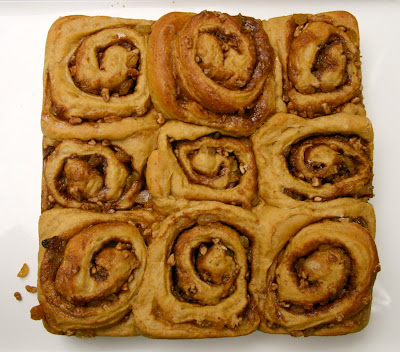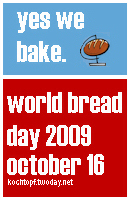
Today is
World Bread Day, and I'm excited to celebrate it on my bread blog! On this day last year, 246 bread bakers around the globe came together over bread. Click
here to see the roundup of the diverse and fabulous breads that they baked and shared with the world. I have no doubt that this year there will be even more breads represented.
At this time last year I wasn't aware of World Bread Day, and had never worked with yeast. The very idea of it scared me! All that changed last November when I baked a
Kugelhopf for the baking group
Tuesdays with Dorie, and I was bitten hard by the bread bug. Christmas saw me stocking up on a few bread-y supplies and in January 2009 my yeast baking began in earnest. The rest, as they say, is history. (You can find my baby steps and early loaves on my other food blog,
The Dogs Eat the Crumbs - click
here to see the posts in my "Adventures in Yeast" series.)

My bread for World Bread Day is the
Simple Milk Loaf. This is a recipe from the creative and generous UK baker
Dan Lepard. One of my Christmas presents was Dan's book
The Art of Handmade Bread, published in the UK as
The Handmade Loaf. It is a volume of "contemporary European recipes for the home baker" and contains a wide array of breads made from every type of grain, many employing sourdough starters. This was heady stuff for a novice baker, but my husband leafed through and stopped right at p. 46: "This Simple Milk Loaf looks great. Why don't you make it?" And so I did. It's a perfectly accessible recipe, with no obscure ingredients or tricky techniques. The resulting loaf was the most delicious farmhouse white bread I've ever tasted. Toasted, with butter, it was the closest I'll come to tasting heaven on earth.

In the past 6 months I've baked this bread countless times, nearly always in a double batch, and always with a healthy dose of whole grain flours. I give at least one loaf of every batch away, and it never fails to receive rave reviews. I've shared the recipe with a couple dozen people, most of whom love it as I do.

The bread can be made with one bowl, one small ramekin, one measuring spoon and a scale. With a 4 hour time period and minimal hands-on work you can produce one of the most versatile and tasty loaves you'll ever eat, right in your very own oven.
 n.o.e.'s notes:
n.o.e.'s notes:- [edit: the original recipe links that I posted are now broken. Please see the recipe at the end of this post, below]
- Here is the easiest way to prepare the dough:
1. Melt the butter. I do that in a ramekin in the microwave.
2. Place a bowl on the digital scale and weigh out the milk and the maple syrup, then warm them slightly in the microwave. Stir in the fresh yeast.
3. Place the bowl back onto the scale and weigh the dry ingredients directly on top of the wet ones. For readers in the US, "strong" flour is the same as bread flour. The standard mix I've come to use is 60% bread flour, and 40% a mixture of oat flour, rye flour, and whole wheat flour. It still comes off as a nearly-white bread, and I like the extra nutty flavor from the whole grains.
4. Mix the wet and dry ingredients with your fingers - the book says to "squidge" it, which is exactly what you're doing. This part will bring you back to your childhood, making mudpies in the backyard. Pour the warm melted butter and squidge some more. This will actually un-stick much of the dough from your fingers.
5. Dan's kneading method is simple, unusual, and very effective - you will knead the dough on an oiled counter for 10 seconds every 10 minutes, for three rounds. The first time, leave the dough on the counter while you wash and dry the bowl. This gives the dough some helpful rest time, Dan says, but if you're in a hurry, you can get a second, clean, bowl out for the kneaded dough. The dough is so supple and delicious to feel, that it's hard to stop kneading after 10 seconds. Nothing bad will happen if you end up giving it an extra knead or 10.

6. The bread rises in the pan very vigorously, and usually gives a good spring in the oven to boot. I've baked it in an 8.5" x 4.5" pan, and a 9" x 5" pan, and in a lot of other unusual sizes. A single batch always yields 900 grams of dough, so that helps in dividing the dough to shape the balls. I've settled on baking double batches in 4 smallish pans, so each ball ends up being 225 grams. It only takes a few minutes to portion the dough, form the balls and drop them into their waiting oiled and floured pans.
 the verdict:
the verdict: This bread is a wonderful way to get your hands into bread-making. It doesn't give sore arms, 30 seconds of kneading is hardly strenuous, but does produce a lovely loaf to eat or to share.
Happy World Bread Day!

I'm also sending this Milk Loaf to
Yeastspotting, a weekly compendium of all things yeasty.
[edit to add recipe, since the links I had are both broken, and further edited on 4/24/11 to add volume measurements:]Simple Milk LoafIngredients
1½ tsp fresh yeast, crumbled [or 1/2 tsp instant yeast, added with dry ingredients]
350g/12oz/1 1/2 cups whole milk, at room temperature, plus extra for brushing
20g/¾oz/1 Tbsp golden or maple syrup
250g/9oz/2 cups plain white flour
250g/9oz/1 3/4 cups strong white flour
1¼ tsp fine sea salt
25g/1oz/2 Tbsp unsalted butter, melted and cooled slightly
olive oil, for greasing
flour, for dusting
Method
1. Preheat the oven to 210C/410F/Gas 6.
2. Place the yeast, milk and syrup into a large bowl and whisk together.
3. Add the flour and salt and mix with your hands to bring together as a soft, sticky dough.
4. Pour over the warm melted butter and mix this into the dough with your hands, then cover the bowl and leave to stand for ten minutes.
5. Grease your hands and a flat clean surface with olive oil. Remove the dough from the bowl and knead for ten seconds, then form the dough into a smooth round ball. Wipe the bowl clean and grease with olive oil, then return the dough ball to the bowl and leave for a further ten minutes.
6. Repeat this ten-second kneading and resting process every ten minutes twice, then leave the dough to rest for 30 minutes.
7. Grease a deep 12x19cm/5x8in loaf tin and dust with flour. Divide the dough into two equal pieces, shape into two balls and place side-by-side into the loaf tin. Cover with a cloth and leave to rise for one and a half hours, or until almost doubled in height.
8. Brush the top of the loaf with a little milk and place into the preheated oven to bake for 15 minutes, then reduce the heat to 180C/350F/Gas 4 and bake for a further 25-30 minutes, or until the top of the loaf is a shiny dark brown and the loaf has come away from the sides of the tin.
9. Remove from the tin and leave to cool on a wire rack.
 I've scaled plenty of recipes in my baking experience, but this is the first time I've cut a Bread Baker's Apprentice recipe by more than half. When it came time to bake Focaccia, the next bread in the Bread Baker's Apprentice Challenge, I was the only person home for an entire week, so I made just 1/6 of the recipe. It turned out to be an adorable little bread and quite tasty too!
I've scaled plenty of recipes in my baking experience, but this is the first time I've cut a Bread Baker's Apprentice recipe by more than half. When it came time to bake Focaccia, the next bread in the Bread Baker's Apprentice Challenge, I was the only person home for an entire week, so I made just 1/6 of the recipe. It turned out to be an adorable little bread and quite tasty too!





















































